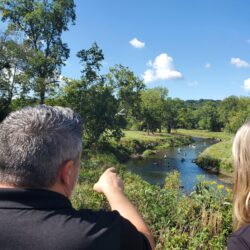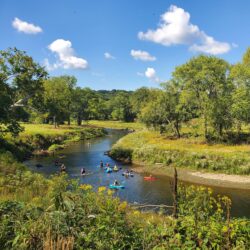EnviroScience is excited to share that the Summit Metro Parks restoration at the former Valley View Golf Course was featured on CNN’s Call to Earth! Summit Metro Parks contracted EnviroScience as the lead engineering and restoration design firm responsible for Phase I and Phase II stream and wetland restoration designs.

EnviroScience’s efforts increased floodplain capacity, restored the natural hydrologic condition, and improved the overall health of the river. EnviroScience has a deep resume of projects (eight projects and counting) where golf courses were restored to provide ecological uplift and solve stormwater, nutrient, and sedimentation issues. In some cases, these restorations were completed on operating golf courses to improve the play and safety of the course while also providing ecological benefits. For example, our Valley View restoration project resulted in the return of bald eagles in 2020.
 EnviroScience’s work, led by Julie Bingham, Director of Ecological Restoration, refined Summit Metro Parks’ original vision for the area into interconnected complexes comprising 200 acres of headwater streams, wetlands, and forest. Environmental Restoration Engineer Angelina Hotz, PE, ENV SP, was the lead engineer and translated the restoration concepts into design plan documents used to bid the two phases. Her efforts and attention to detail were integral to the success of the project.
EnviroScience’s work, led by Julie Bingham, Director of Ecological Restoration, refined Summit Metro Parks’ original vision for the area into interconnected complexes comprising 200 acres of headwater streams, wetlands, and forest. Environmental Restoration Engineer Angelina Hotz, PE, ENV SP, was the lead engineer and translated the restoration concepts into design plan documents used to bid the two phases. Her efforts and attention to detail were integral to the success of the project.
Phase I focused on the captured drainage ways and swales from the golf course to daylight the water into streams, natural drainage ways, and wetlands that connect to a large remnant oxbow wetland of the Cuyahoga River. This phase constructed approximately 14 acres of wetlands and 2,250 linear feet of six headwater streams.
Phase II focused on the Cuyahoga River corridor, an approximately 5,000 linear-foot reach, improving the floodplain and in-stream habitat. Sediment in the river, bank erosion, and low habitat diversity characterized the reach prior to the project. Furthermore, the banks were previously levied by the golf course to limit flooding.
The restoration approach aimed to improve these impairments by excavating approximately 44,000 cubic yards to create expansive floodplains that will now be regularly inundated. The resultant lower banks reduced (and, in some areas, eliminated) erosion by drastically decreasing water depth and energy and providing overbank areas for the deposit of fine silts.
Click here to view CNN’s outstanding footage of the project site in its “Rewilding a Golf Course” video story.
Previously, these sediments were deposited in the river, embedding the gravel and cobble streambed and creating a sandy “desert” underwater that did not support ecological diversity. To enhance the in-stream habitat, the EnviroScience team meticulously positioned hundreds of boulders in clusters and orientations to promote localized scour and flow diversity.
 Our restoration experts placed repurposed wood from previous floodplain excavations on the streambanks and underwater to create additional habitat and erosion protection. Many of the existing trees along the river were strategically conserved—not only to encourage future tree recruitment and wildlife habitats but also to enhance the site’s aesthetics. Floodplain excavations were prioritized for areas with low tree density and morphologic importance.
Our restoration experts placed repurposed wood from previous floodplain excavations on the streambanks and underwater to create additional habitat and erosion protection. Many of the existing trees along the river were strategically conserved—not only to encourage future tree recruitment and wildlife habitats but also to enhance the site’s aesthetics. Floodplain excavations were prioritized for areas with low tree density and morphologic importance.
The project implementation also required extensive native plantings, a long-term invasive species (vegetation management) plan, and an invasive plant control component.
EnviroScience managed the in-house design and provided construction oversight as one seamless service. We couldn’t be more pleased to see our work captured so beautifully and are honored to see our commitment to “excellence in any environment” showcased on CNN’s Call to Earth.
To learn more about EnviroScience’s unique approaches to ecological restoration and other complex environmental problems, please contact us, and one of our experts will get back to you within 24 hours.
Few environmental firms in the country retain EnviroScience’s degree of scientific know-how, talent, and capability under one roof. The diverse backgrounds of our biologists, environmental engineers, scientists, and divers enable us to provide comprehensive in-house services and an integrated approach to solving environmental challenges—saving clients time, reducing costs, and ensuring high-quality results.
Our client guarantee is to provide “Excellence in Any Environment,” meaning no matter what we do, we will deliver on our Core Values of respect, client advocacy, quality work, accountability, teamwork, and safety. EnviroScience was created with the concept that we could solve complex problems by empowering great people. This concept still holds true today as our scientists explore the latest environmental legislation and regulations and incorporate the most up-to-date technology to gather and report data.
EnviroScience expertise includes but is not limited to aquatic surveys (including macroinvertebrate surveys and biological assessments); ecological restoration; ecological services (including impact assessments, invasive species control, and water quality monitoring); emergency response; engineering and compliance services; endangered mussel surveys; laboratory and analysis; stormwater management; threatened and endangered species; and wetlands and streams (including delineation and mitigation). Further, EnviroScience is one of the few biological firms in the country that is a general member of the Association of Diving Contractors International (ADCI) and offers full-service commercial diving services.



